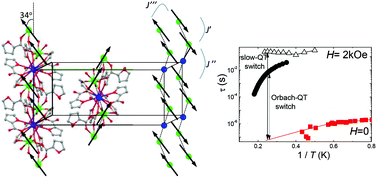Magnetic relaxation versus 3D long-range ordering in {Dy2Ba(α-fur)8}n furoate polymers†
Abstract
A novel Dy-complex formulated as {[Dy2Ba(α-C4H3OCOO)8·(H2O)4]·2H2O}n, {Dy2Ba(α-fur)8}n, has been synthesized, structurally characterized, and magnetically and thermally investigated as a function of field and temperature, down to 85 mK. The α-furoate ligands consolidate 1D zig-zag chains formed by Dy2 dimers separated by Ba ions. Ab initio calculations were used to determine the easy anisotropy axis direction, the gyromagnetic tensor components and the energy levels of each Dy. The heat capacity and susceptibility measurements allowed us to conclude that intradimer and interdimer interactions are ferromagnetic and of the same order, J′/kB ≈ J′′/kB = +0.55 K. In the absence of an applied magnetic field, the dynamic relaxation of the magnetization occurs through the fast (τT ∼ 10−5 s) spin-reversal of each of the individual Dys through a quantum tunneling (QT) process. A long-range 3D ordered state is achieved at TN = 0.25 K, in which the ferromagnetically coupled zig-zag chains (J′/kB ≈ J′′/kB = +0.528(1) K) running along the c-axis are antiferromagnetically coupled to the adjacent chains (J′′′/kB = −0.021(1) K). Critical slowing down of the QT time constant is observed when the temperature approaches TN. Under the application of a magnetic field, the QT relaxation is replaced by an Orbach process (with energy barrier U/kB = 68 K and τ0 ∼ 10−9 s at H = 2 kOe) and a very slow (τs ∼ 0.2 s) relaxation process. We propose and demonstrate the proof of concept of a spintronic device, in which two different relaxation rates can be selected, and on/off switched by magnetic field biasing. The dynamical behavior of this compound is compared with another furoate to discuss the effect of competitive interactions.


 Please wait while we load your content...
Please wait while we load your content...